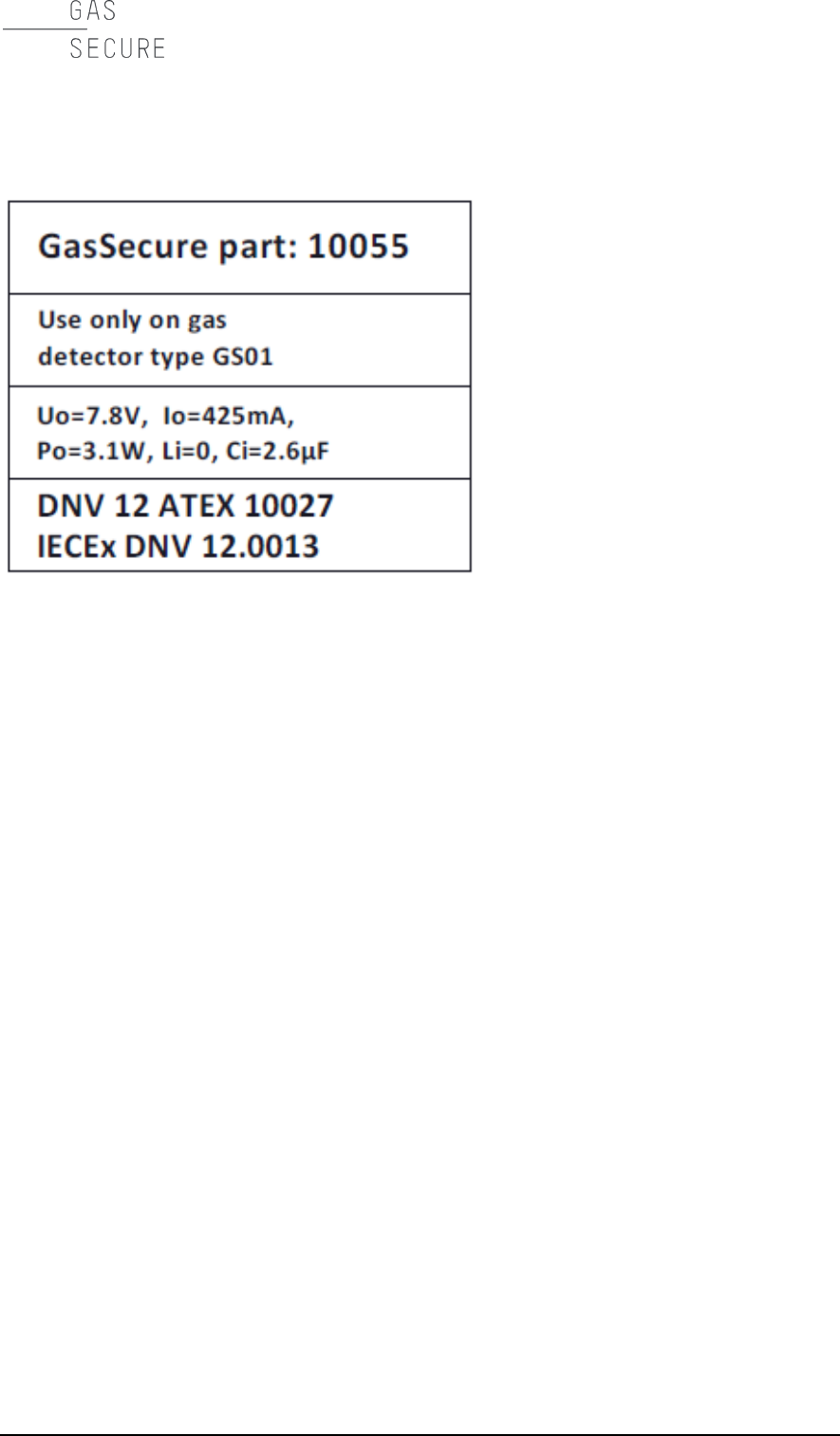GasSecure AS GS01AA Wireless gas detector User Manual GasSecure GS01 Hardware Manual
GasSecure AS Wireless gas detector GasSecure GS01 Hardware Manual
Contents
- 1. Users Manual
- 2. user manual
Users Manual

GasSecure GS01
Wireless Infrared Hydrocarbon
Gas Detector
User Manual
Document ID: 1395 Contact info
Release: 5 GasSecure AS
Version: 103 Hoffsveien 70 C
Doc. Status: APPROVED N-0377 Oslo
Last modified: 22.04.2015 Norway
www.gassecure.com
post@gassecure.com

GasSecure GS01
Hardware Manual
I
Note
Those who have or will have the responsibility for the operation or maintenance of
this product must carefully read this manual. The product may not perform as
designed if it is not used and maintained in accordance with the manufacturer’s
instructions.
Please read the complete manual and particularly note the paragraphs having an
exclamation mark in the margin.
This manual covers installation, operation and maintenance of the GS01 wireless
hydrocarbon detector and its battery pack.
The product warranty issued by GasSecure is voided if the product is not used
and maintained as described in this manual.
Please read also the safety instructions in Section 6.
GasSecure AS, all rights reserved.

GasSecure GS01
Hardware Manual
II
PRODUCT DATA
Manufacturer GasSecure AS
Country of origin Norway
Model GS01
Gases and range Hydrocarbons, 0 – 100% LEL
1
Environmental conditions
Certified temperature
2
-40oC to +65oC
Humidity 0 to 100% RH
Pressure influence, 700 – 1300 hPa ≤ 0.15% of reading per hPa
(at 50% LEL)
Protection classification IP 66 and IP 67
Electrical
RF power 10 dBm (10 mW)
Battery type Lithium-Thionyl Chloride
Battery cells Tadiran SL-2780/S or TL-5930/S
Average power 5 mW
Explosion Protection II 2G Ex ib IIC T4 Gb
1
Available configurations: Methane, Propane, Methanol
2
Battery temperature limitation -30oC

GasSecure GS01
Hardware Manual
III
TABLE OF CONTENTS
1. PRODUCT DESCRIPTION ........................................................................................................5
1.1 GENERAL .................................................................................................................................5
1.2 MEASURING PRINCIPLE .............................................................................................................5
1.3 INSTRUMENT DESCRIPTION ........................................................................................................6
1.4 BATTERY ..................................................................................................................................6
1.5 OUTLINE DIMENSIONS ...............................................................................................................6
2. INSTALLATION ..........................................................................................................................9
2.1 TOOLS .....................................................................................................................................9
2.2 MOUNTING ...............................................................................................................................9
2.3 GROUNDING .............................................................................................................................9
2.4 SUN SHADE / WEATHER PROTECTION .......................................................................................10
3. COMMISSIONING ....................................................................................................................11
3.1 COMMUNICATION ....................................................................................................................11
3.2 ISA100 WIRELESS™ STANDARD .............................................................................................11
3.3 ISA100 OBJECTS ....................................................................................................................11
3.4 GS01 DATA FORMAT DETAILS ..................................................................................................13
3.5 COMMUNICATION MONITORING ................................................................................................13
3.6 GS01 DETECTOR PROVISIONING .............................................................................................14
3.7 MODIFICATIONS TO AN EXISTING NETWORK ..............................................................................15
3.8 VISUAL AND FUNCTIONAL CHECK .............................................................................................16
4. OPERATION .............................................................................................................................17
4.1 NORMAL OPERATION ...............................................................................................................17
4.2 VALIDATION ............................................................................................................................17
5. MAINTENANCE .......................................................................................................................18
5.1 ROUTINE MAINTENANCE ..........................................................................................................18
5.2 SPARE PARTS .........................................................................................................................18
5.3 CLEANING ..............................................................................................................................18
5.4 BATTERY PACK .......................................................................................................................19
5.5 STORAGE ...............................................................................................................................22
5.6 TROUBLESHOOTING ................................................................................................................22
5.7 CONTACT GASSECURE FOR SUPPORT .....................................................................................24
6. SAFETY INSTRUCTIONS ........................................................................................................25
7. CERTIFICATIONS AND STANDARDS ....................................................................................26
7.1 STANDARDS ...........................................................................................................................26
7.2 REGULATORY COMPLIANCE OF RADIO ......................................................................................27
7.3 MARKING ...............................................................................................................................27
8. TECHNICAL DATA ..................................................................................................................30
8.1 PERFORMANCE CHARACTERISTICS ..........................................................................................30
8.2 CROSS SENSITIVITIES .............................................................................................................30
9. REFERENCES .........................................................................................................................32
10. APPENDIX ...........................................................................................................................33

GasSecure GS01
Hardware Manual
IV
FIGURES
FIGURE 1-1: GS01 DETECTOR LAYOUT................................................................................................................ 6
FIGURE 1-2: GS01 DETECTOR WITH DIMENSIONS IN [MM] ................................................................................... 7
FIGURE 1-3: GS01 MEASURING CELL DETAILS ..................................................................................................... 8
FIGURE 2-1: CORRECT POSITION OF THE WEATHER CAP AND LOCATION OF EARTH POINT. ................................. 10
FIGURE 3-1: GS PROVISIONING TOOL ............................................................................................................... 15
FIGURE 5-1: BATTERY PACK WARNING LABEL ................................................................................................... 20
FIGURE 5-2: BATTERY PACK BOTTOM VIEW ...................................................................................................... 20
FIGURE 5-3: BATTERY PACK TOP AND BOTTOM ................................................................................................. 21
FIGURE 7-1: GS01 PRODUCT IDENTIFICATION PLATE ......................................................................................... 27
FIGURE 7-2: FCC COMPLIANCE LABEL .............................................................................................................. 28
FIGURE 7-3: BATTERY PACK IDENTIFICATION LABEL ......................................................................................... 29
TABLES
TABLE 3-1 ISA100 OBJECTS ............................................................................................................................. 12
TABLE 3-2 PV GAS MEASUREMENT DATA INTEGRITY ....................................................................................... 13
TABLE 4-1 RECOMMENDED GAS CONCENTRATIONS FOR VALIDATION ............................................................... 17
TABLE 5-1: IMPORTANT SPARE PARTS FOR THE GS01 ....................................................................................... 18
TABLE 5-2: STATUS MESSAGES RETRIEVED FROM THE DIAG_STATUS ATTRIBUTE ............................................ 23
TABLE 7-1: LIST OF APPLICABLE STANDARDS FOR THE GS01 ............................................................................ 26
TABLE 8-1: PERFORMANCE CHARACTERISTICS FOR THE GS01.......................................................................... 30
TABLE 8-2: LEL VALUES IN [% VOL] ACCORDING TO IEC60079-20. ................................................................ 31
TABLE 8-3 CROSS SENSITIVITIES FOR A GS01 METHANE DETECTOR. ............................................................... 31
TABLE 8-4 CROSS SENSITIVITIES FOR A GS01 PROPANE DETECTOR. ................................................................ 31
TABLE 8-5: CROSS SENSITIVITIES FOR A GS01 METHANOL DETECTOR. ............................................................. 31
TABLE 10-1: PV_STATUS BYTE DESCRIPTION ACCORDING TO ISA100 WIRELESS™ STANDARD....................... 33
TABLE 10-2: CONTENT OF THE DIAG_STATUS ATTRIBUTE ............................................................................ 33

GasSecure GS01
Hardware Manual
DESCRIPTION
5
1. PRODUCT DESCRIPTION
1.1 General
The GS01 is a wireless, battery powered point detector that monitors the
concentration of hydrocarbon gases.
It uses a combination of two sensors:
1. An ultrasonic speed-of-sound sensor that continuously monitors changes in
the ambient air composition.
2. An optical (infrared) absorption sensor that is used for accurate
measurements of the hydrocarbon gas concentration.
The infrared sensor uses more power than the ultrasonic and is therefore kept in
hibernation if the ultrasonic sensor does not detect any changes in the air
composition. The infrared sensor applies optical MEMS (micro electromechanical
system) technology to enable intermittent operation with fast start-up and
measurement, and thus a low average battery consumption.
The measured gas concentration is transmitted wireless using the ISA100
Wireless™ standard. This manual does not cover the wireless router or gateway
and the connected control system (please refer to the list of references in Section
9 providing examples of relevant documentation).
The detector is intrinsically safe, with equipment protection level Gb (Ex ib) (see
Section 7) intended for use in zone 1 and 2 areas.
1.2 Measuring principle
The GS01 detector utilises infrared absorption spectroscopy. The fundament is
the Beer-Lambert Law, which relates the absorption of light to the properties of the
material through which the light is travelling.
The internal radiation source emits infrared radiation through a lens and a
sapphire window into the measuring cell (cf. Figure 1-1 and Figure 1-3). A mirror
at the opposite end of this cell returns the beam back through the sapphire
window into the internal volume of the detector and onto a filter that disperses,
focuses, and modulates the incident light. This filter is a patented silicon MEMS
component proprietary to GasSecure.
By applying a control voltage to the MEMS chip it is switched between the so-
called gas state and the reference state. In the gas state a wavelength where
hydrocarbons do absorb light is focused onto the detector, whereas two
wavelengths where hydrocarbons do not absorb are focused onto the detector in
the reference state. The GS01 detector uses the same light source, light path and
photodetector for both measurements.
This single beam, triple wavelength detection is unique to the GS01 from
GasSecure.
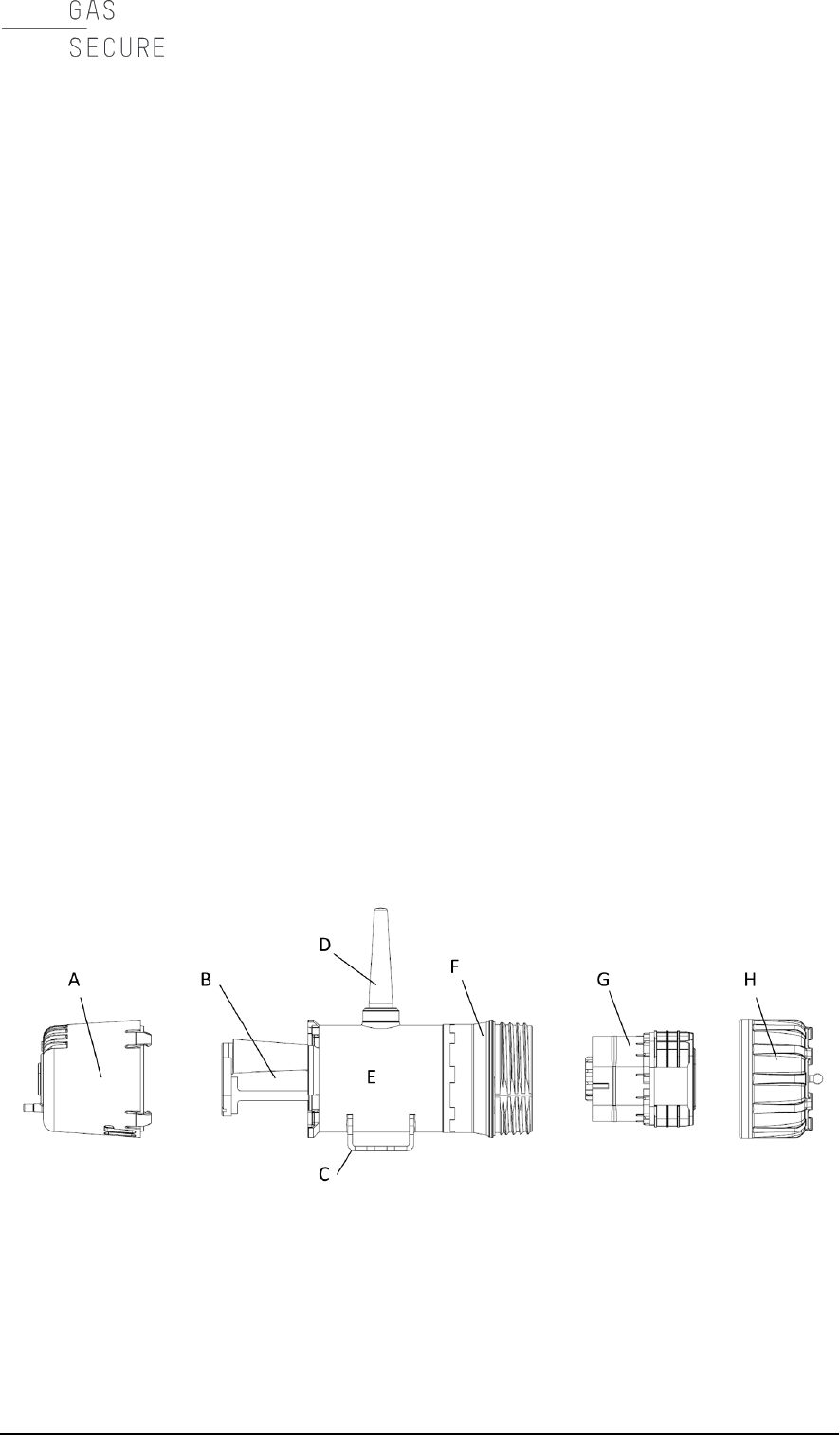
GasSecure GS01
Hardware Manual
6 CHAPTER 1
1.3 Instrument description
The GS01 consists of the main housing (316L stainless steel) with mounting
bracket, the measuring cell, an antenna, and the battery compartment (cf. Figure
1-1). Attached to the main housing are the following detachable parts:
Weather cap (Polyamide 6)
Battery cap (Polyamide 6)
Battery package (Polyamide 6)
Except for these detachable parts, the user shall not disassemble the sensor any
further. When the weather cap is removed, the infrared measuring cell with the
sapphire window on the main housing and the mirror at the outer end, is open and
accessible for cleaning. The ultrasonic sensor is protected by a perforated steel
sheet, which shall not be removed.
1.4 Battery
The GS01 may only be used with the GasSecure battery pack (Part number
10055). The battery pack is designed for two Lithium-Thionyl Chloride size D cells
in series, and has a nominal output voltage of 7.2V. The battery pack has an
internal charge counter. The battery pack is intrinsically safe as well (see Section
7).
1.5 Outline dimensions
Figure 1-1 shows the sensor buildup with an exploded drawing, and Figure 1-2
depicts the GS01 dimensions.
Figure 1-1: GS01 detector layout
with A) Weather cap, B) Measuring cell, C) Mounting bracket, D) Antenna, E)
Stainless steel housing, F) Battery compartment, G) Battery pack, H) Battery cap
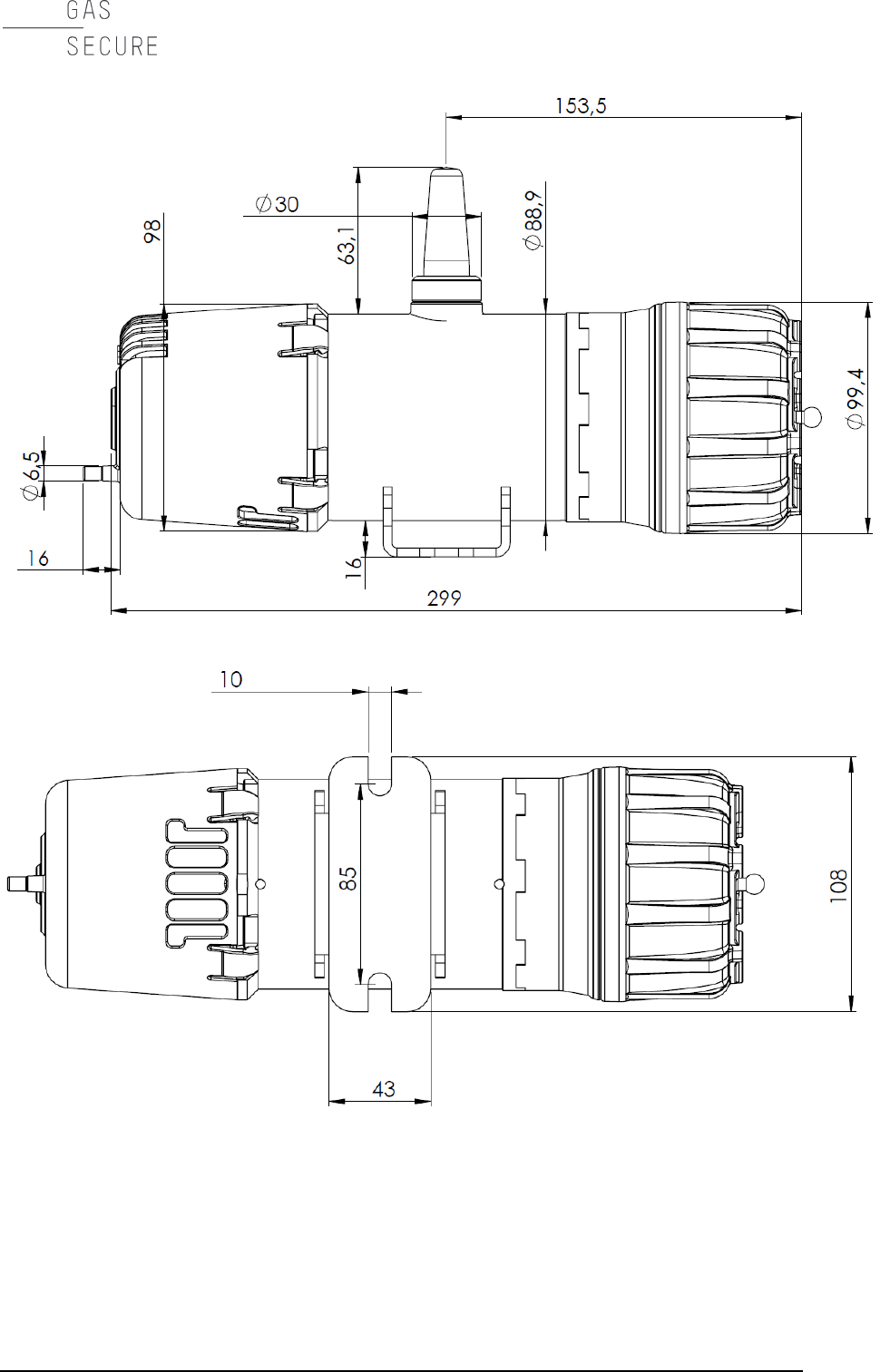
GasSecure GS01
Hardware Manual
DESCRIPTION
7
Figure 1-2: GS01 detector with dimensions in [mm]
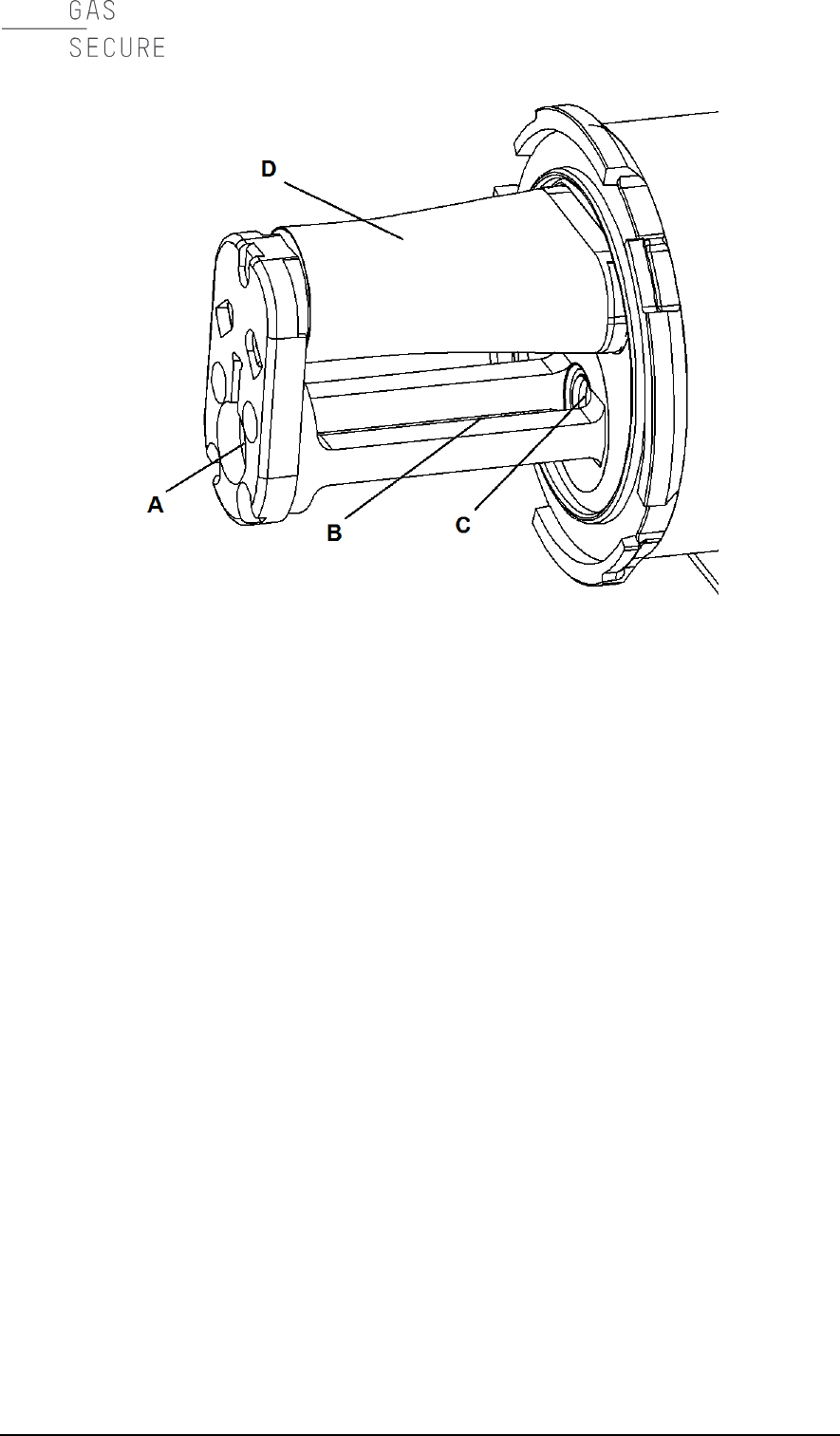
GasSecure GS01
Hardware Manual
8 CHAPTER 1
Figure 1-3: GS01 measuring cell details
showing A) External mirror, B) Infrared beam path, C) Sapphire window, D)
Ultrasonic sensor with protective sheet
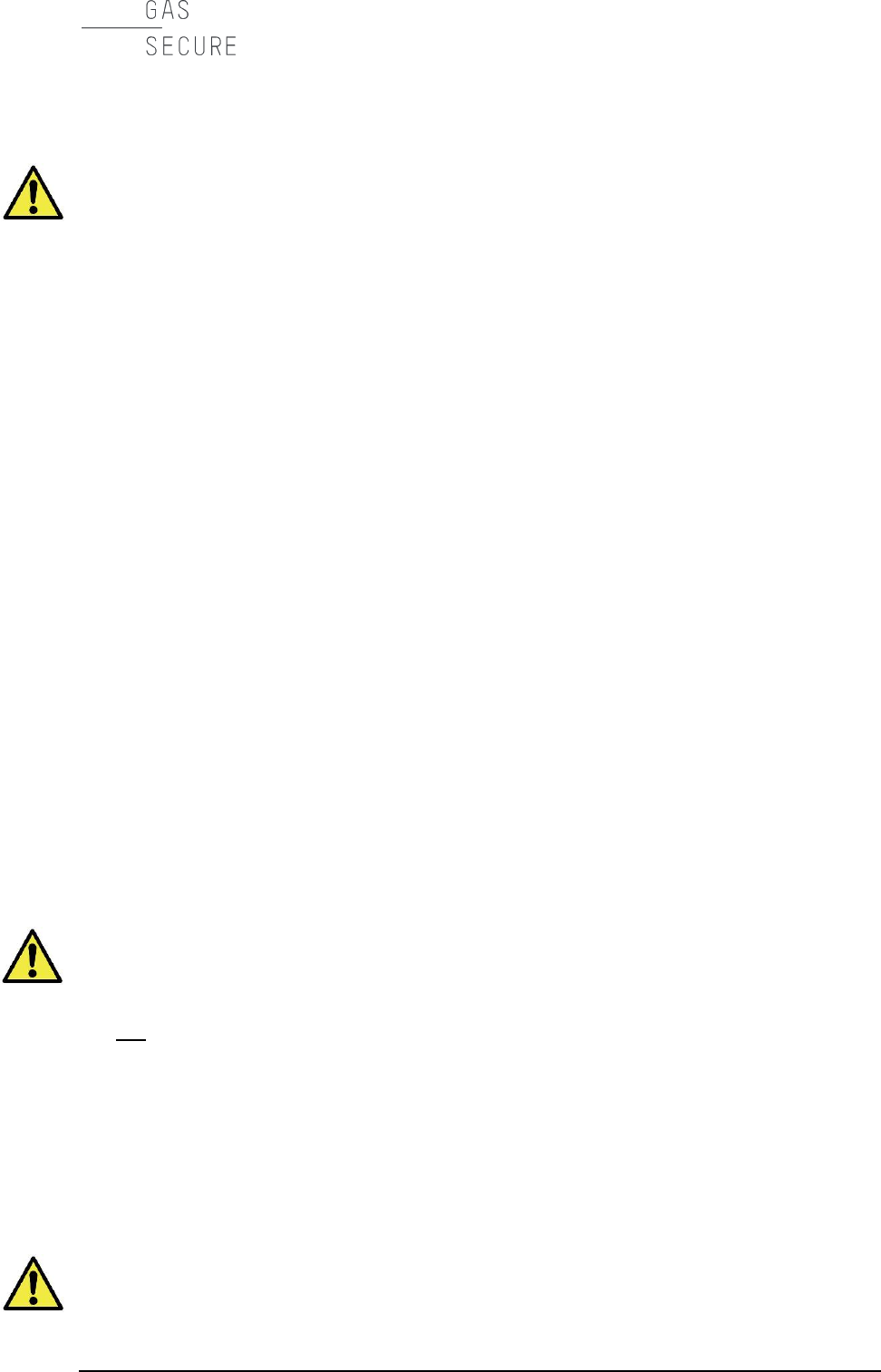
GasSecure GS01
Hardware Manual
INSTALLATION
9
2. INSTALLATION
Note: The GS01 gas detector certification must comply with the legal requirements
following the area classification at the installation point.
The detector shall be installed where it is most likely to detect gas in the event of a
leakage.
For battery pack installation see Section 5.4.
In areas with significant exposure to direct sunlight and the risk of temperatures
beyond the operating temperature range, a sunshade should be considered (see
list of spare parts in Table 5-1).
2.1 Tools
The following tools are needed to install the instrument:
Open-end spanner for M8 bolts (alternatively 5/16” bolts)
Face spanner with two pins in size 75x6 (distance x pin diameter) as
optional tool to remove the battery cap
2.2 Mounting
The detector is mounted with its long axis horizontally. Make sure, to the extent
possible, that the antenna is vertical (pointing up or down) and that local radio
shadowing is kept at a minimum.
Two M8 bolts (alternatively 5/16” bolts) with washers under the head are used to
attach the bracket. The bolts should be spaced from 85 to 95 mm to easily fit the
slots when mounting the detector.
The weather cap must be mounted with the arrow on the cap pointing upwards,
regardless if the antenna is pointing up or down (cf. Figure 2-1). If possible, mount
the GS01 with the weather cap oriented away from the prevailing wind direction.
Do not use the GS01 detector in ventilation ducts or pipes.
Do not mount the detector directly above hot or cold surfaces. If the detector is
mounted inside metallic structures or enclosures the need for a GS01 detector
with extendable antenna should be considered. Contact GasSecure for more
information on this option.
2.3 Grounding
The detector housing must be connected to ground for operation in hazardous
areas. This to avoid possible static charge build-up, which may arise from
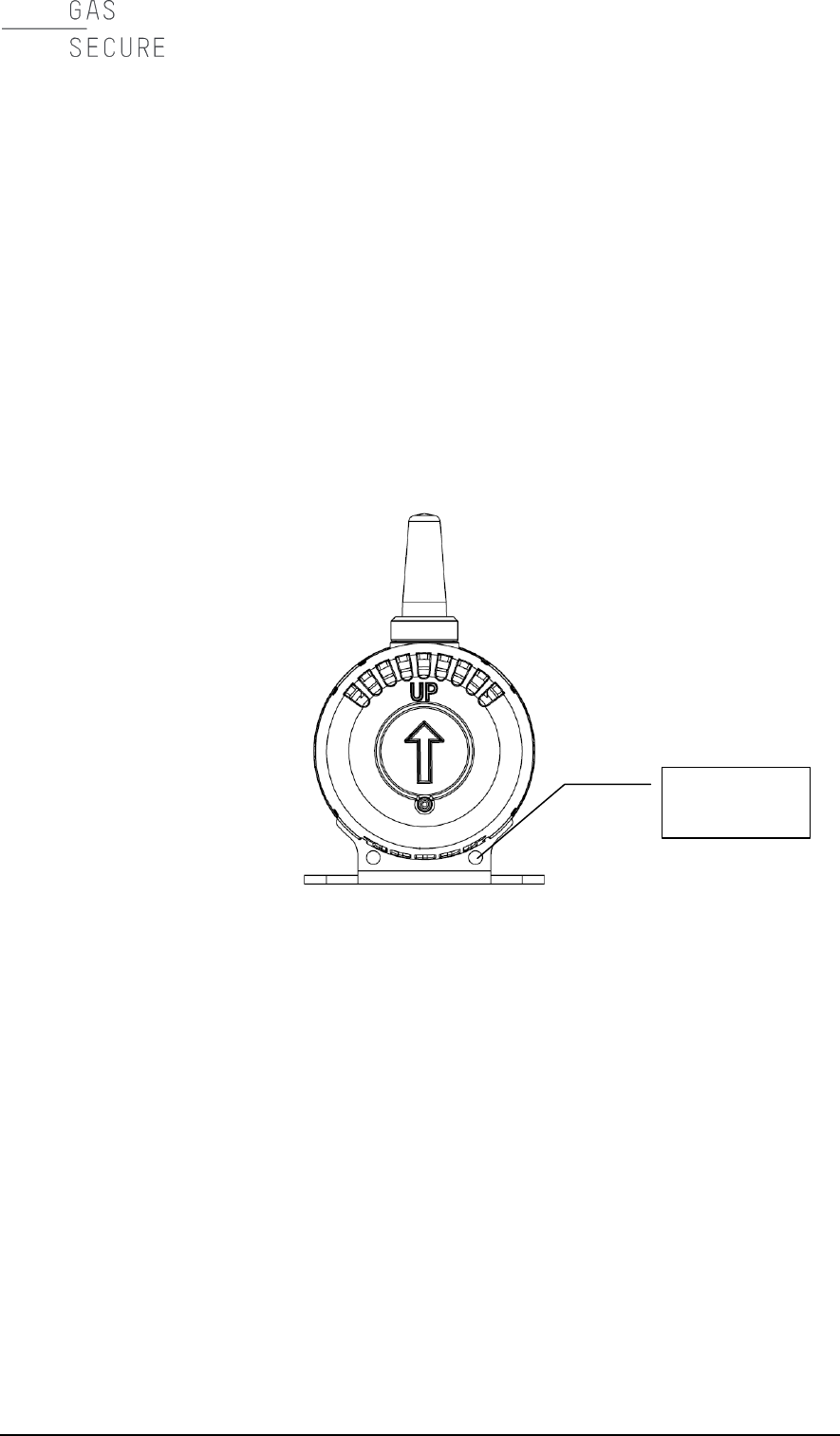
GasSecure GS01
Hardware Manual
10 CHAPTER 2
electrically isolated metal parts. Ground the detector either by mounting it on a
grounded metallic structure or by connecting a grounded wire to the screw holes in
the mounting bracket (cf. Figure 2-1). For the latter the wire should be minimum 4
mm2 (AWG 8) and as short as possible.
2.4 Sun shade / weather protection
The sun shade is available as optional accessory and recommended for locations
with high ambient temperature and / or direct sunlight exposure. It may also be
used as weather protection for instance in locations with frequent heavy
precipitation. The shade is fixed to the gas detector bracket with the same M8 (or
5/16”) bolts which are used for detector mounting. Make sure that the sun shade
is mounted the correct way so that the detector identification plate remains visible.
Figure 2-1: Correct position of the weather cap and location of earth point.
The arrow must always point up even if the antenna is pointing down.
External
earth point

GasSecure GS01
Hardware Manual
COMMISSIONING
11
3. COMMISSIONING
The GS01 detector(s) is (are) set up in a wireless sensor network with a gateway
and router. The exact commissioning procedure depends on the selected type of
gateway. Therefore this manual must be used together with the relevant
documentation written for the respective gateway. Some references for such
documentation are provided in Section 9.
3.1 Communication
The GS01 detector complies with the ISA100 Wireless™ standard for wireless
communication.
Each GS01 detector must be paired with a single gateway, before it can
communicate with the network. The gateway is the interface between the wireless
and plant networks. It marks the transition between communications compliant to
the standard and other communications, and acts as a translator between ISA100
Wireless™ and other protocols (Modbus, PROFInet, etc.).
The pairing process, where the device obtains the appropriate security credentials
and network-specific information, is referred to as provisioning and is explained in
Section 3.6.
3.2 ISA100 Wireless™ standard
ISA100 Wireless™ is a wireless networking technology standard developed by the
International Society of Automation (ISA).
This ISA standard is intended to provide reliable and secure wireless operation for
safety, control, and monitoring applications. This standard defines the protocol
suite, system management, gateway, and security specifications for low-data-rate
wireless connectivity with fixed, portable, and moving field devices supporting very
limited power consumption requirements. The application focus is to address the
performance needs for periodic monitoring and process control where latencies on
the order of 100 ms can be tolerated with optional behaviour for shorter latency.
3.3 ISA100 objects
ISA100.11a defines a communication protocol, with an application layer that
includes a simple but extensible set of input and output objects.
The GS01 detector publishes the measured values and diagnostic information as
ISA100 objects and attributes. It is distinguished between standard attributes and
GS01 device specific attributes.
3.3.1 Standard objects
The GS01 publishes ISA100 standard objects and attributes for process value and
diagnostic status as outlined in Table 3-1 below. The gas measurement value is
sent as User Application - Analog Input Object with the attribute “Process Value”

GasSecure GS01
Hardware Manual
12 CHAPTER 3
(PV). The device health information is compiled and sent as User Application
Management Object with the attribute “Diagnostic Status” (DIAG_STATUS).
The concentrator of the gas detector is per default set up to publish the gas
measurement and the diagnostic status. The concentrator can be configured
differently in the gateway interface.
For short detector response time (<5 sec as per GS01 datasheet), the gateway
must be set up with a 2 sec sampling interval (also referred to as publication
period). In the absence of hydrocarbon gas, the detector will not publish on all
available time slots, but publish at approximately 1/4 of the timeout time defined
by the stale limit. (cf. Section 3.5) in order to save battery power. In the presence
of hydrocarbon gas of sufficient concentration (defined by the internal low alarm
limit see Table 8-1), all time slots will be used.
Table 3-1 ISA100 objects
Descriptive
name
Access
-ibility
Octet
no.
Content
Modbus input
registers
Data type
PV
READ
1
PV_Status
Register N
UINT 16 bit
2
PV_Value (1/4)
Register N+1
32 bit (4 octets)
float, according to
IEEE
754_Float32
3
PV_Value (2/4)
4
PV_Value (3/4)
Register N+2
5
PV_Value (4/4)
DIAG_STATUS
READ
1
Diag_Status (1/4)
Register M
UINT 16 bit
2
Diag_Status (2/4)
3
Diag_Status (3/4)
Register M+1
4
Diag_Status (4/4)
Note that the content of the PV_Status byte (PV = process value) is explained in
Table 10-1 in the Appendix.
The full mapping of the content of the DIAG_STATUS attribute is explained in
Table 10-2 in the Appendix.
Recommendations for which status and diagnostic information to integrate in the
control and maintenance loop are also provided in the Appendix.
3.3.2 GS01 specific objects
In addition to the standard objects, the GS01 can be configured to publish and
subscribe to custom data objects. These objects are used for PROFIsafe
communication over PROFInet via the gateway. Contact GasSecure for further
information about GS01 specific objects if this option is considered.

GasSecure GS01
Hardware Manual
COMMISSIONING
13
3.4 GS01 data format details
The GS01 data objects can be mapped into 16 bit Modbus input registers.
The “PV” object (cf. Section 3.3.1) normally populates three registers; the
PV_Status byte populates the last 8 bits of the first register and the 32 bit float
number populates the following two registers.
The “UAPMO.DIAG_STATUS” object (cf. Section 3.3.1) is normally mapped into
two 16 bit registers. Some gateways will also add a status byte into the preceding
register. This status byte may be ignored, because its information is already
contained in the PV_status byte.
The procedure for Modbus register mapping depends on the specific gateway,
please consult the respective gateway manual on how to achieve this mapping.
GasSecure can assist with advice if needed.
3.5 Communication monitoring
The PV_Status byte (see Table 3-1) can be used for monitoring the
communication status and the data integrity. See Table 10-1 in the Appendix for
all details. If the detector communicates with the gateway, the status byte will be
decimal value 64 or higher; please refer to Table 3-2 below for the three main
classes of data integrity.
Table 3-2 PV Gas measurement data integrity
Data integrity
Octet decimal
number
Explanation and actions
Bad
< 64
No communication or hardware failure.
Check communication. Contact GasSecure if
this failure persists.
Uncertain
64 to 127
The integrity of the data is uncertain. As
example the sensor range or temperature
range may be exceeded.
Good
= 128
Normal operation. The detector is providing
reliable gas measurements.
The status byte is updated by the gateway if the communication with the detector
is lost. The time from reception of the last packet and until the status byte is
updated to flag “lost communication” is defined via the stale limit parameter.
Please consult the gateway manual for information about setting this stale limit.
GasSecure’s recommendation is a sampling interval of 2 sec (see Section 3.3.1)
together with a stale limit of 30 times, so that “lost communication” is flagged after
maximum 60 sec. Under no circumstances the product of sampling interval and
stale limit must be set to less than 10 sec, because this would disable
communication between detector and gateway.

GasSecure GS01
Hardware Manual
14 CHAPTER 3
Note that the timeout, as defined by the stale limit, can be checked by removing
the battery and monitoring the time until the PV_Status byte is updated.
3.6 GS01 detector provisioning
All GS01 detectors have to be provisioned so that they will join the correct
network. Provisioning the GS01 requires the following:
• An USB serial adapter interface to GS01 together with GS Provisioning
Tool software (both accessories from GasSecure)
• The network (or subnet) ID of the gateway or backbone router
This procedure can be carried out with an unprovisioned GS01 or with a GS01
that earlier has been provisioned to another gateway.
3.6.1 Yokogawa gateways
a) Connect the GS01 to a PC with the GS Provisioning Tool installed using the
USB serial adapter interface. Allow 20 sec. for the booting of the device.
b) Run the GS Provisioning Tool and select the correct COM port. Press the
“Connect” button and verify that the device info is displayed, cf. Figure 3-1.
c) Enter the required network ID (make sure the correct number format is
selected: Decimal, Hex, Octal or Binary) and device tag, cf. Figure 3-1.
d) Verify that “randomize join key” is selected and specify the destination
folder for the YPIF file. This file must be uploaded to the gateway
(explained in reference [RD 4]) to enable communication. Press the “do
provisioning” button. Verify that the “Provisioning is done!” message is
displayed in the command window.
e) Close and exit the GS Provisioning Tool and disconnect the GS01 detector
from the PC.
f) Power up the GS01 by inserting the battery pack.
g) The GS01 device should join the network within 5-20 minutes, if it is within
radio distance to the gateway and the gateway is set up properly (refer to
reference [RD 4]).
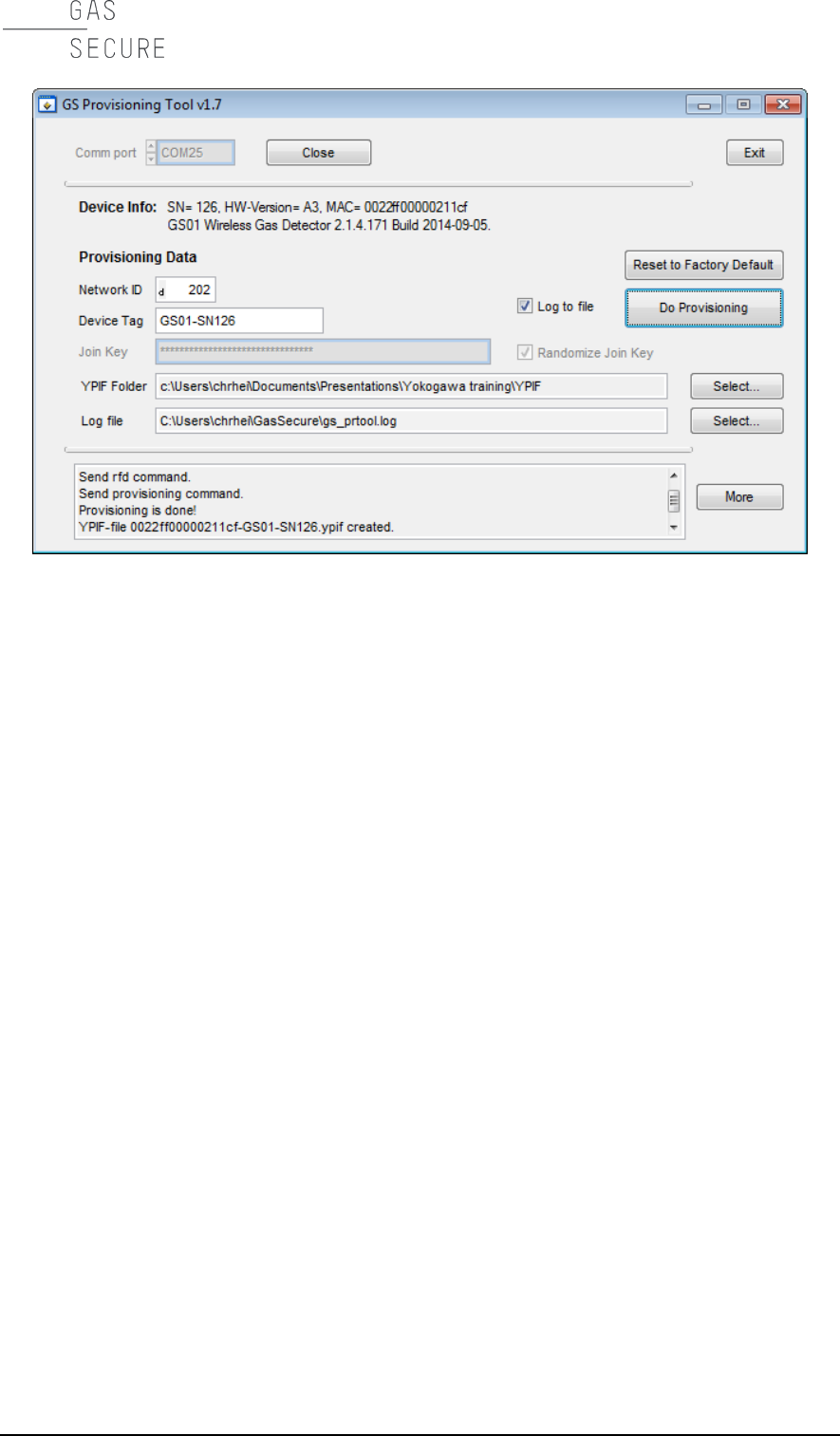
GasSecure GS01
Hardware Manual
COMMISSIONING
15
Figure 3-1: GS Provisioning Tool
3.6.2 Other ISA100 Wireless gateways
a) Connect the GS01 to a PC with the GS Provisioning Tool installed using the
USB serial adapter interface. Allow 20 sec. for the booting of the device.
b) Run the GS Provisioning Tool and select the correct COM port. Press the
“Connect” button and verify that the device info is displayed.
c) Press the “Reset to Factory Default” button.
d) Close and exit the GS Provisioning Tool and disconnect the GS01 detector
from the PC.
e) Power up the GS01 by inserting the battery pack.
f) The GS01 can now be provisioned over the air (OTA) using either special
field tools or the field wireless access points. Refer to references [RD6] or
[RD 8] for possible solutions from different vendors.
g) The GS01 device should join the network within 5-20 minutes, if it is within
radio distance to the gateway and the gateway is set up properly.
3.7 Modifications to an existing network
1. Add a detector
Provision the GS01 as described in Section 3.6.
Mount the GS01 with battery.
Re-configure the gateway to accommodate the additional detector(s) (cf.
Section 9 for gateway relevant documentation).

GasSecure GS01
Hardware Manual
16 CHAPTER 3
2. Replace a detector
Power down the GS01 in question by removing its battery.
Provision the replacement GS01 by following all steps in Section 3.6.
Mount the replacement GS01 with battery.
Re-configure the gateway to accommodate the replacement detector(s) (cf.
Section 9 for gateway relevant documentation).
3. Remove a detector
Power down the GS01 in question by removing its battery pack.
Optional: Re-configure the gateway in order to remove the detector from
the list of publishers (cf. Section 9 for gateway relevant documentation).
3.8 Visual and functional check
The following activities are recommended before putting into operation the GS01
detector:
The axis of the detector shall be horizontal.
Verify the correct orientation of the weather cap (cf. Figure 2-1).
Check that all bolts and screws are securely tightened.
Carry out a validation as described in Section 4.2.

GasSecure GS01
Hardware Manual
MAINTENANCE
17
4. OPERATION
The GS01 has no user adjustable parts. Do not open the instrument. Opening the
GS01 detector voids the warranty issued by the manufacturer.
4.1 Normal operation
After provisioning the GS01 detector with an ISA100 Wireless™ gateway, it will
perform the following tasks:
Measure gas concentration
Publish gas concentration to the gateway
Publish other diagnostic information to the gateway
4.2 Validation
Note that the GS01 is calibrated according to IEC60079-20, which states an LEL
value of 4.4 %vol for Methane.
Although no re-calibration of the GS01 is necessary, it is recommended to check
the response of the detector once per year by applying pressurized test gas.
The weather cap is designed for validation, as it includes a 6 mm diameter tube
fitting for efficiently filling the GS01 measuring cell with a test gas mixture. Note
however that the test gas will leak out during testing and leakage will depend on
the wind speed. Therefore, the measured gas concentration is normally lower than
stated on the test gas cylinder. It is not recommended to carry out validation in
stronger wind, or alternatively the weather cap has to be covered on the outside in
this case, i.e. by applying tape to the openings.
The function of the detector is positively validated as long as it responds to the
test gas.
Please refer to Table 4-1 for the recommended gas mixtures and expected
instrument readings. Apply the test gas through a 6 mm tube from a gas cylinder
with pressure regulator. It is recommended to adjust the pressure to 0.6 – 0.8 bar
relative or alternatively the flow to 5 – 8 l/min.
Table 4-1 Recommended gas concentrations for validation
Detector version
Recommended test gas
Expected reading
Methane 0-100%LEL
Methane 2.2 % vol in
synthetic air
Or alt. 2.5 % vol in synth. air
50 % LEL
57 %LEL
Propane 0-100%LEL
Propane 0.42 % vol in
synthetic air
25 % LEL
Methanol 0-100%LEL
17 % LEL

GasSecure GS01
Hardware Manual
18 CHAPTER 5
5. MAINTENANCE
The GS01 detector is designed to reduce maintenance to a minimum.
The instrument does not have user adjustable parts. Do not attempt to open or
disassemble the instrument. This can compromise safety and performance.
Opening the GS01 voids the warranty issued by the manufacturer. All repairs have
to be done by the manufacturer or by an authorised dealer.
5.1 Routine maintenance
For best performance it is recommended to routinely carry out the following steps:
Clean the window and mirror when necessary (see Section 5.3 below). The
optical transmission of the infrared sensor maybe monitored with the
DIAG_STATUS attribute explained in Table 5-2 and Table 10-2.
Check the weather cap regularly to make sure it is not clogged (see Section
5.3 below).
Check battery status regularly. Replace low batteries in due time (see Section
5.4 below). The battery status maybe monitored with the DIAG_STATUS
attribute explained in Table 5-2 and Table 10-2.
Check the detector response every year (see Section 4.2).
5.2 Spare parts
Table 5-1: Important spare parts for the GS01
Description
Part number
Battery pack (type Li-SOCl2 2xD)
10055
Weather cap
10078
Battery cap
10022
Sunshade
10123
5.3 Cleaning
In the event of low or blocked optical transmission of the IR sensor, the optical
window and external mirror (see Figure 1-3 for their exact location) should be
cleaned. The detector functionality is still as normal.
Please proceed as follows:
Remove battery to avoid unwanted alarms while cleaning.

GasSecure GS01
Hardware Manual
MAINTENANCE
19
Use soft tissue or a cotton swab and a lens cleaning fluid based on pure
water and isopropyl alcohol (IPA) and/or other alcohols.
Flush or wipe with pure water afterwards, and dry off with a soft dry tissue.
Reinstall the battery.
Note that gas alarms are likely to occur during and shortly after cleaning
due to the detector’s sensitivity to alcohol. This is avoided by removing the
battery while cleaning.
Other cleaning agents are not recommended, but if lens cleaning fluid or
IPA is not available, a diluted dishwasher detergent may be used if followed
by a thorough flushing with pure water. Dry off any remaining water
droplets.
The inside of the ultrasonic sensor does not need cleaning. If the perforated sheet
is clogged with dirt, clean compressed air may be used for removal.
If the detector is installed in an area where the weather cap may become clogged
(for instance by insects, leaves, ice or snow), it is recommended that this cap is
inspected regularly to make sure that air flows freely through the openings.
5.4 Battery pack
Note that the GS01 may only be operated with the GasSecure battery pack (p/n
10055).
5.4.1 Battery pack replacement
The battery pack is installed or replaced simply by twisting off the battery cap,
pulling out the old pack, pushing the new one in place, and putting back the cap.
The battery pack will only fit one way, so that correct polarity is ensured. After
inserting the battery pack, it may take up to 15 minutes before the detector is
transmitting data, depending on how the network is set up.
5.4.2 Battery cell replacement
The battery cells in the battery pack can be replaced. Assemble the battery pack
as described below.
Caution!
Only use battery packs that
are designed for battery cell replacement. They will contain the label
depicted in Figure 5-1. Battery packs without this label may not be opened.
are clean and free of contamination.
are visually intact (particularly no damage around the screw holes).
have no visible corrosion on the terminal contacts.
Battery cell replacement and opening the battery pack must take place in a safe
area, where a potential explosive atmosphere is not present.
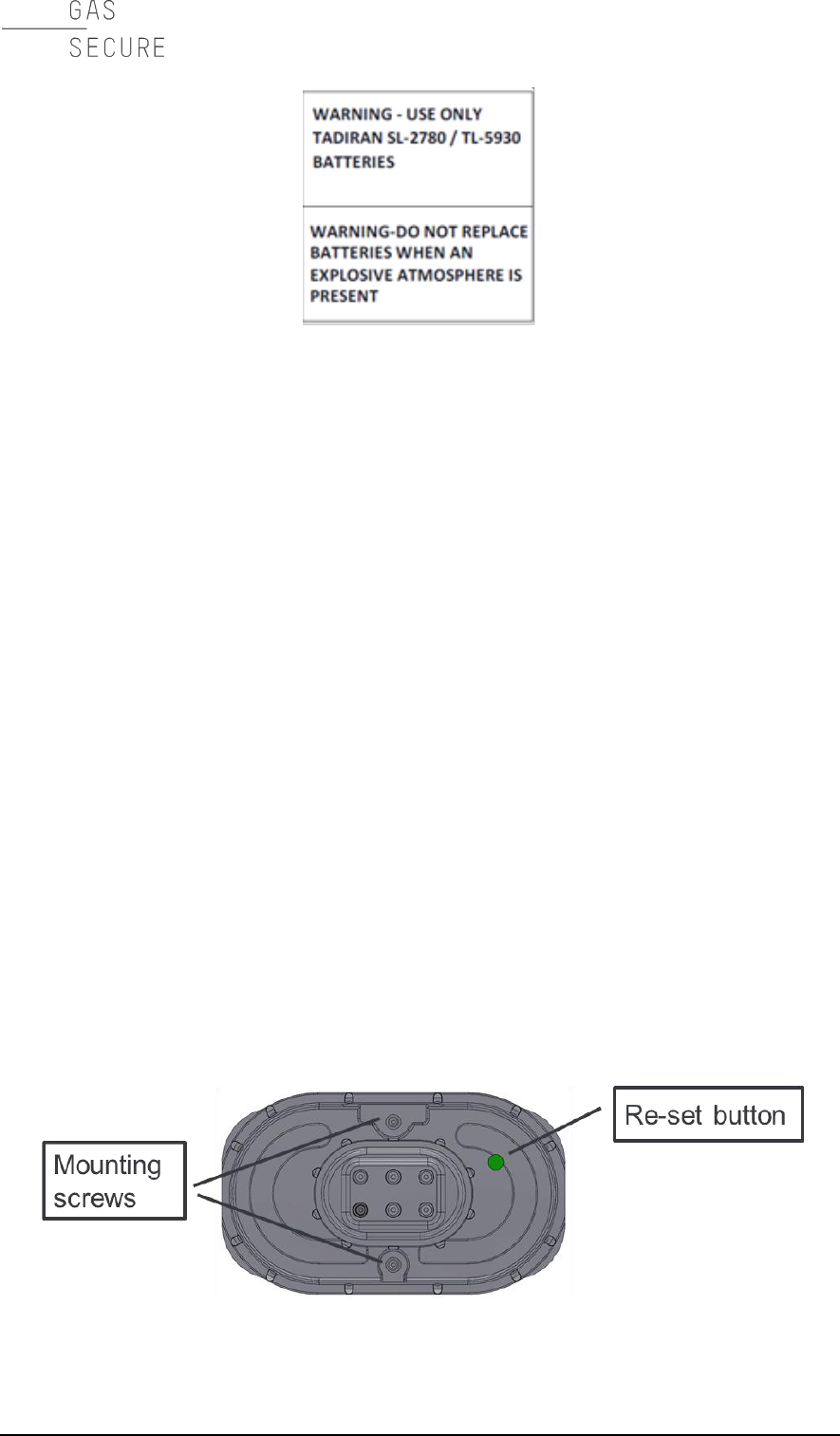
GasSecure GS01
Hardware Manual
20 CHAPTER 5
Figure 5-1: Battery pack warning label
Replacement:
Loosen the two battery pack mounting screws, see Figure 5-2. Note that
the spring force is high, have therefore a firm grip around the pack while
unscrewing.
Remove both used cells and dispose according to the battery cell safety
datasheet (see Section 5.4.3 for more information). Do not disassemble the
battery pack any further.
Verify that new cells are of the correct type (cf. Section 5.4.3). Be sure to
replace both battery cells at the same time and only use fresh (previously
unused) cells.
Place both battery cells in the battery pack, leaf contact facing the positive
(+) terminal and spring contact facing the negative (-) terminal, cf. Figure 5-
3.
Assemble lid and bottom of the pack by tightening the two screws with a
torque of approximately 0.7 Nm. Have a firm grip around the pack until the
screws are tight.
Press the button on the pack, see Figure 5-2. This will indicate to the gas
detector that fresh batteries are in place and re-set the charge counter.
Note that only gas detectors with firmware 3.0 or later will recognize this
button operation. Please contact GasSecure should the detector in
question contain an older firmware version or should you be uncertain
about the firmware of this detector.
Figure 5-2: Battery pack bottom view
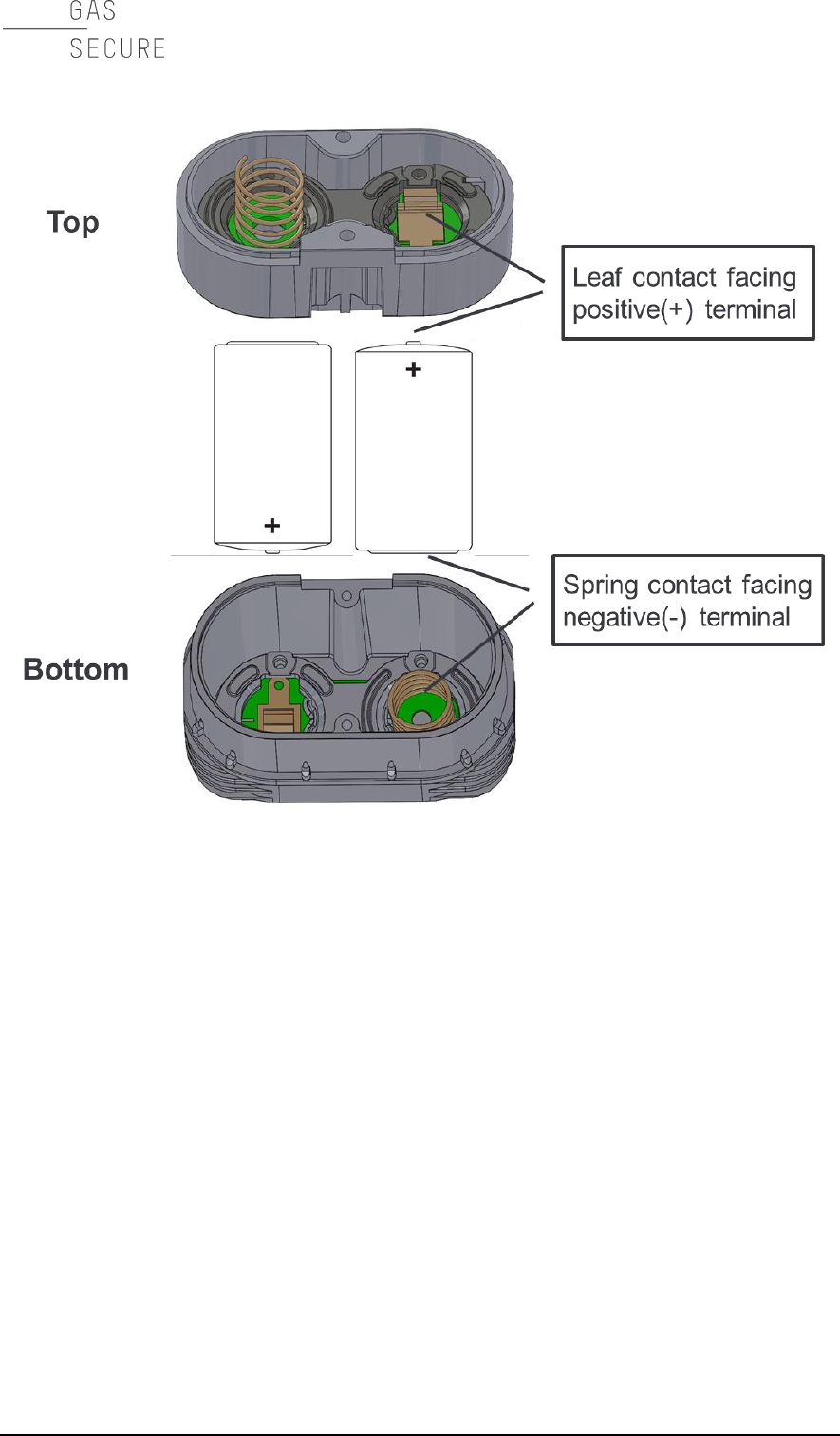
GasSecure GS01
Hardware Manual
MAINTENANCE
21
Figure 5-3: Battery pack top and bottom
with leaf and spring contacts facing the battery positive (+) and negative (-)
terminal, respectively.
5.4.3 Handling battery packs and cells
The battery pack comprises two primary lithium thionyl chloride battery cells.
Under normal conditions, the battery materials are self-contained and are not
reactive as long as the battery cell and pack integrity are maintained. Care should
be taken to prevent thermal, electrical or mechanical damage. Protect the
electrode of the battery cells to avoid short circuits. Shorted battery cells may leak
fluid and produce excessive heat. Batteries should be stored in a clean and dry
area. For maximum battery life, storage temperature should not exceed 25°C.

GasSecure GS01
Hardware Manual
22 CHAPTER 5
Warning.Fire, explosion, and severe burn hazard!
Never recharge a battery pack or cell.
Do not disassemble the battery cells.
Do not incinerate, heat above 100°C, or expose battery packs and cells to
water.
Please consult the battery cell material safety datasheet for further information.
Use only the following approved battery cells in the battery pack:
Tadiran model no. SL-2780/S
Tadiran model no. TL-5930/S
Transport
Batteries used for the GS01 detector contain lithium. Transport of primary lithium
batteries is regulated by the U.S. Department of Transportation, the International
Air Transport Association (IATA), the International Civil Aviation Organization
(ICAO), and the European Ground Transportation of Dangerous Goods (ARD). It
is the responsibility of the shipper to ensure compliance with these or any other
local requirements. Consult current regulations and requirements before shipping.
When carried or transported, a battery pack with cells shall be kept in an anti-
static bag.
Disposal
The battery pack is considered as hazardous waste. Please dispose of it
accordingto laws and regulations for such waste. In the European Union directive
2006/66/EC must be respected.
5.5 Storage
The battery pack shall be disconnected when the detector is stored away or not in
service for longer periods. This is to avoid that the batteries are depleted.
5.6 Troubleshooting
Essential instrument status information is provided through the standard ISA100
Wireless object “DIAG_STATUS” (cf. Section 3.3.1). Please refer to the Appendix
for a recommended implementation of the GS01 status and diagnostic
information. The “Diag_Status” attribute provides the information as outlined in
Table 5-2.
For failures (mode F) not explained in Table 5-2, please clean window and mirror
(cf. Section 5.3). If the failure persists, contact GasSecure.

GasSecure GS01
Hardware Manual
MAINTENANCE
23
Table 5-2: Status messages retrieved from the Diag_Status attribute
Instrument
mode
(cf. Table 10-2)
DIAG_STATUS
bit set
(cf. Table 10-2)
Explanation and actions
M
19
Low battery.
The battery must be replaced soon.
F and M
20
Empty battery.
Replace battery immediately (see Section 5.4).
M
7
Attenuated optical beam (low optical
transmission).
The instrument detects low light transmission
and infrared signal strength most probably due
to dirty optics. Clean the window and mirror if
necessary (cf. Section 5.3).
F and M
8
Beam block (optical beam fault).
The signal is so weak that the gas
concentration cannot be calculated with
sufficient accuracy.
Check for dirty optics and clean the window
and mirror (cf. Section 5.3) if necessary.
O
22
The system temperature is outside the
specified operating range. For repeated high
temperature warnings the use of a sunshade
should be considered.
M
21
Malfunction of the detector. The detector still
provides reliable measurements, but has
detected one of the following problems:
- increased energy consumption and
reduced battery lifetime.
- increased probability for beam block.
- increased probability that the detector
periodically will be unable to provide
measurements.
Clean the window and mirror (cf. Section 5.3).
Contact GasSecure if this failure persists.

GasSecure GS01
Hardware Manual
24 CHAPTER 5
5.7 Contact GasSecure for support
You will find our contact information and an updated list of our representatives on
our homepage
www.gassecure.com
When contacting the factory for support, the following information should be
provided: - The instrument serial number
- Description of the failure
- The type of gateway used for wireless communication

GasSecure GS01
Hardware Manual
SAFETY INSTRUCTIONS
25
6. SAFETY INSTRUCTIONS
The GS01 detector from GasSecure is certified for and intended for use in
potentially hazardous areas. Install and use the GS01 detector in accordance with
the appropriate local or national regulations.
Test gases (for calibration or validation) may be toxic and/or combustible. Refer to
the Material Safety Sheets for appropriate warnings.
The gas detector shall be installed and operated by trained and qualified
personnel.
Remember to secure the GS01 detector when working at heights.
Do not open the instrument. All warranties void if opened. There are no user
serviceable parts or settings inside. The manufacturer or its authorised dealers
shall do service or repair.

GasSecure GS01
Hardware Manual
26 CHAPTER 7
7. CERTIFICATIONS AND STANDARDS
7.1 Standards
The GS01 has been certified according to the ATEX Directive 94/9/EC, EMC
Directive 2004/108/EC, R&TTE Directive 1999/95/EC and is compliant with the
standards listed below.
Table 7-1: List of applicable standards for the GS01
Standard
Issue date
Title
EN 60079-0
2012
Electrical apparatus for potentially explo-
sive atmospheres. General requirements.
EN 60079-11
2012
Electrical apparatus for potentially explosive
atmospheres. Intrinsic safety “i”.
IEC 60079-0
2011
Explosive atmospheres – Part 0: Equipment.
General requirements.
IEC 60079-11
2011
Equipment protection by intrinsic safety "i".
IEC 60079-29-1
2007
Gas detectors – Performance requirements
of detectors for flammable gases.
EN 60945
2002
Maritime navigation and radio-
communication equipment and systems.
General requirements. Methods of testing
and required test results.
EN 50270
2006
Electromagnetic compatibility. Electrical
apparatus for the detection and measure-
ment of combustible gases, toxic gases or
oxygen.
EN 61000-6-3: 2007
+A1 (2011)
2007 and
2011
Electromagnetic compatibility (EMC) - Part
6-3: Generic standards. Emission standard
for residential, commercial and light-
industrial environments.
ETSI/EN 300-328
2012-04
Electromagnetic compatibility and Radio
spectrum Matters (ERM).
IEC 61508 Ed. 2.0
2010-04
Functional safety of electrical, electronic,
programmable electronic safety-related
systems
CFR title 47 Part 15C
Code of federal regulations, telecom-
munications, radio frequency devices,
intentional radiators
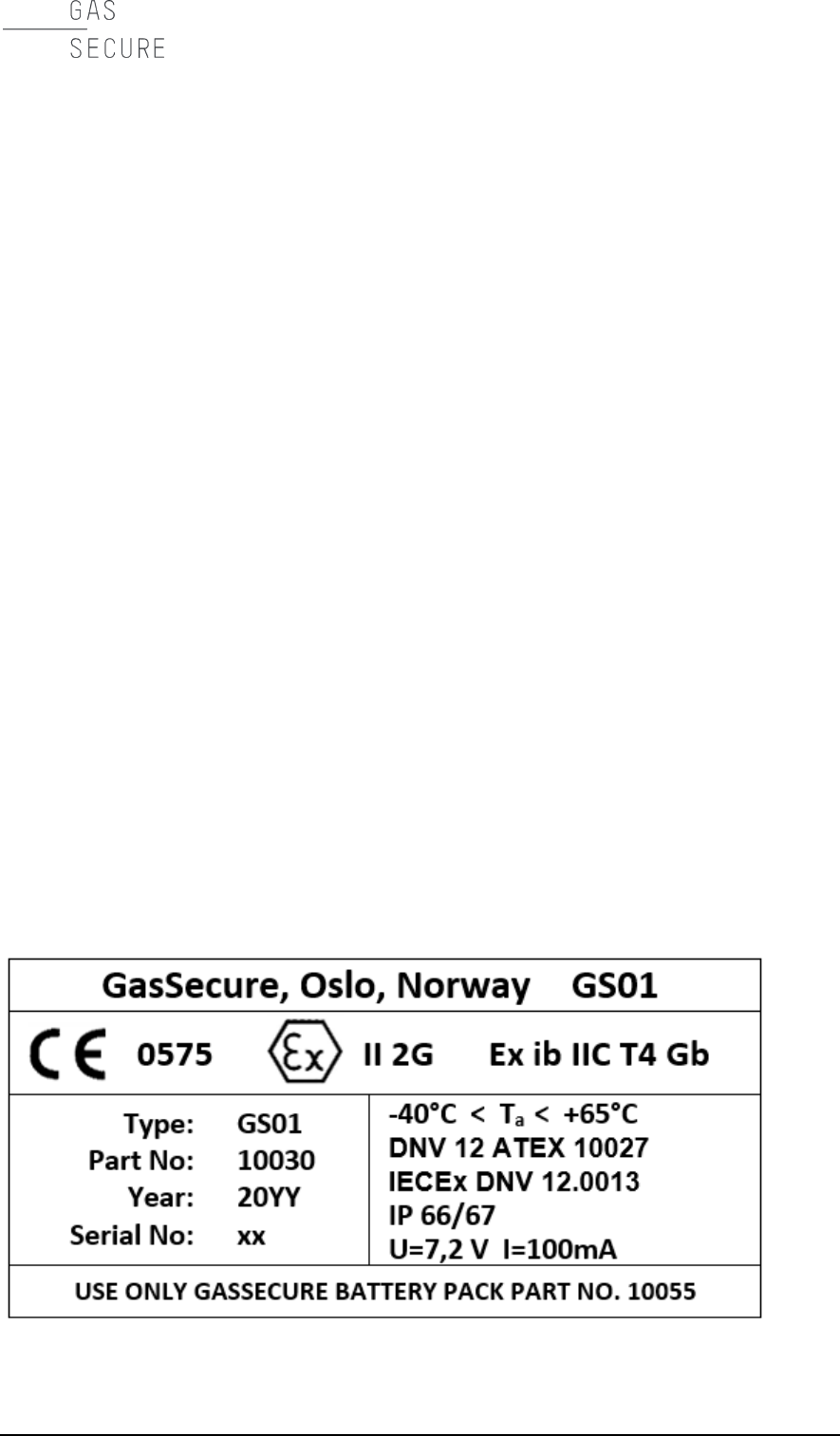
GasSecure GS01
Hardware Manual
CERTIFICATIONS
27
7.2 Regulatory compliance of radio
7.2.1 Terminal equipment directive (R&TTE)
GasSecure hereby declares that the GS01 wireless gas detector complies with the
essential requirements and provisions of R&TTE Directive 1999/95/EC.
7.2.2 FCC compliance
This device complies with Part 15 of the FCC Rules. Operation is subject to the
following two conditions: (1) this device may not cause harmful interference, and
(2) this device must accept any interference received, including interference that
may cause undesired operation.
Changes or modifications to the equipment not expressly approved by the party
responsible for compliance could void the user's authority to operate the
equipment.
This equipment has been tested and found to comply with the limits for a Class A
digital device, pursuant to Part 15 of the FCC Rules. These limits are designed to
provide reasonable protection against harmful interference when the equipment is
operated in a commercial environment. This equipment generates, uses, and can
radiate radio frequency energy and, if not installed and used in accordance with
the instruction manual, may cause harmful interference to radio communications.
Operation of this equipment in a residential area is likely to cause harmful
interference in which case the user will be required to correct the interference at
his own expense.
7.3 Marking
The GS01 detector is marked with a product identification plate (cf. Figure 7-1)
and a label for FCC compliance (cf.Figure 7-2). The composition of the
identification plate is in accordance with ATEX Directive 94/9/EC. The marking is
explained in detail under the figure.
Figure 7-1: GS01 product identification plate
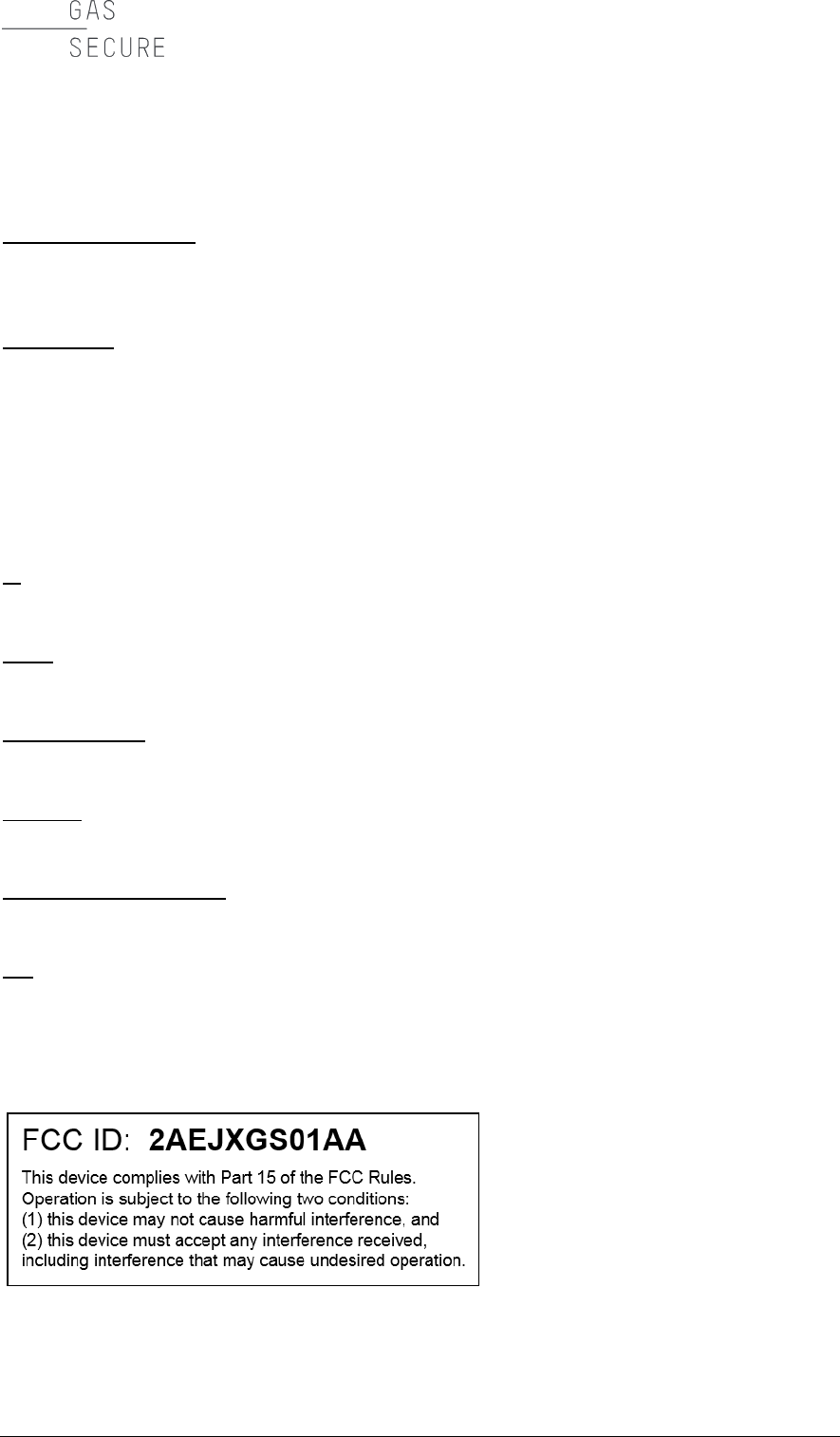
GasSecure GS01
Hardware Manual
28 CHAPTER 7
The instrument marking string II 2G Ex ib IIC T4 Gb
means the following
Equipment group II
Electrical apparatus for places with an explosive gas atmosphere other than mines
susceptible to firedamp.
Category 2
Equipment designed to be capable of functioning in conformity with the operating
parameters established by the manufacturer and of ensuring a high level of
protection. Equipment in this category is intended for use in areas in which
explosive atmospheres caused by vapours, gases, mists, or air/dust mixtures are
likely to occur. The means of protection relating to equipment in this category
ensure the requisite level of protection even on the event of frequently occurring
disturbances or equipment faults, which normally have to be taken into account.
G
The instrument is approved for use in gas, vapour, and mist atmospheres.
Ex ib
The method of protection is “intrinsic safety”.
Gas group IIC
Not restricted to certain gases.
IP66/67
Ingress protection level (as defined in EN 60529).
Temperature class T4
The maximum surface temperature of components will not exceed 135 oC.
Gb
Equipment protection level “Gb”: Equipment for explosive gas atmospheres,
having a "high" level of protection, which is not a source of ignition in normal
operation or during expected malfunctions.
Figure 7-2: FCC compliance label

GasSecure GS01
Hardware Manual
30 CHAPTER 8
8. TECHNICAL DATA
8.1 Performance Characteristics
Table 8-1: Performance characteristics for the GS01
Detector Version
GS01-01A
GS01-02A
GS01-03A
Calibration Gas
Methane
Propane
Methanol
Measuring Range3
0 – 100% LEL
0 – 100% LEL
0 – 100% LEL
Internal Low Alarm Limit4
10% LEL
10% LEL
10% LEL
Initialization time
30 s
Response
time
Detector
5 s > 10% LEL
5 s > 30% LEL
5 s > 50% LEL
Incl. wireless comm.5
7 s > 10%LEL
7 s > 30%LEL
7 s > 50% LEL
Maximum for low
concentrations6
60 s < 10%LEL
60 s < 30%LEL
60 s < 50% LEL
Accuracy7
± 3% LEL
( < 50% LEL)
± 2% LEL
± 20% of
reading
whichever is
greater
± 2% LEL
± 20% of
reading
whichever is
greater
± 5% LEL
(> 50% LEL)
Dead band suppression
± 4% LEL
± 3% LEL
± 3% LEL
Typical battery life time8
2 years
2 years
2 years
8.2 Cross sensitivities
The GS01 is sensitive to many hydrocarbon gases, and does not distinguish one
from another. In the tables below cross sensitivities to important hydrocarbon
gases are presented. Please note that these are modelled estimates and shall be
used as an indication only. Please contact GasSecure for cross sensitivity
estimates for other gases than those listed below.
The tables are read as follows: The instrument reading is looked up in the first
column. The estimated actual concentration is found in the same row in the
column for the gas to be measured.
Example: If a methane detector is exposed to ethanol and a value of 40 %LEL is
read, the actual concentration of ethanol is approximately 15 %LEL.
All values in are in % LEL. LEL values as provided in Table 8-2.
3
LEL limits according to IEC60079-20
4
Refer to Section 3.3.1 for further explanation
5
Assuming an optimized network configuration using the default publish period of 2 seconds.
6
Due to the limited sensitivity of the ultrasonic sensor
7
Refers to temperature range -20 to +50 oC
8
Assuming non-condensing environment.
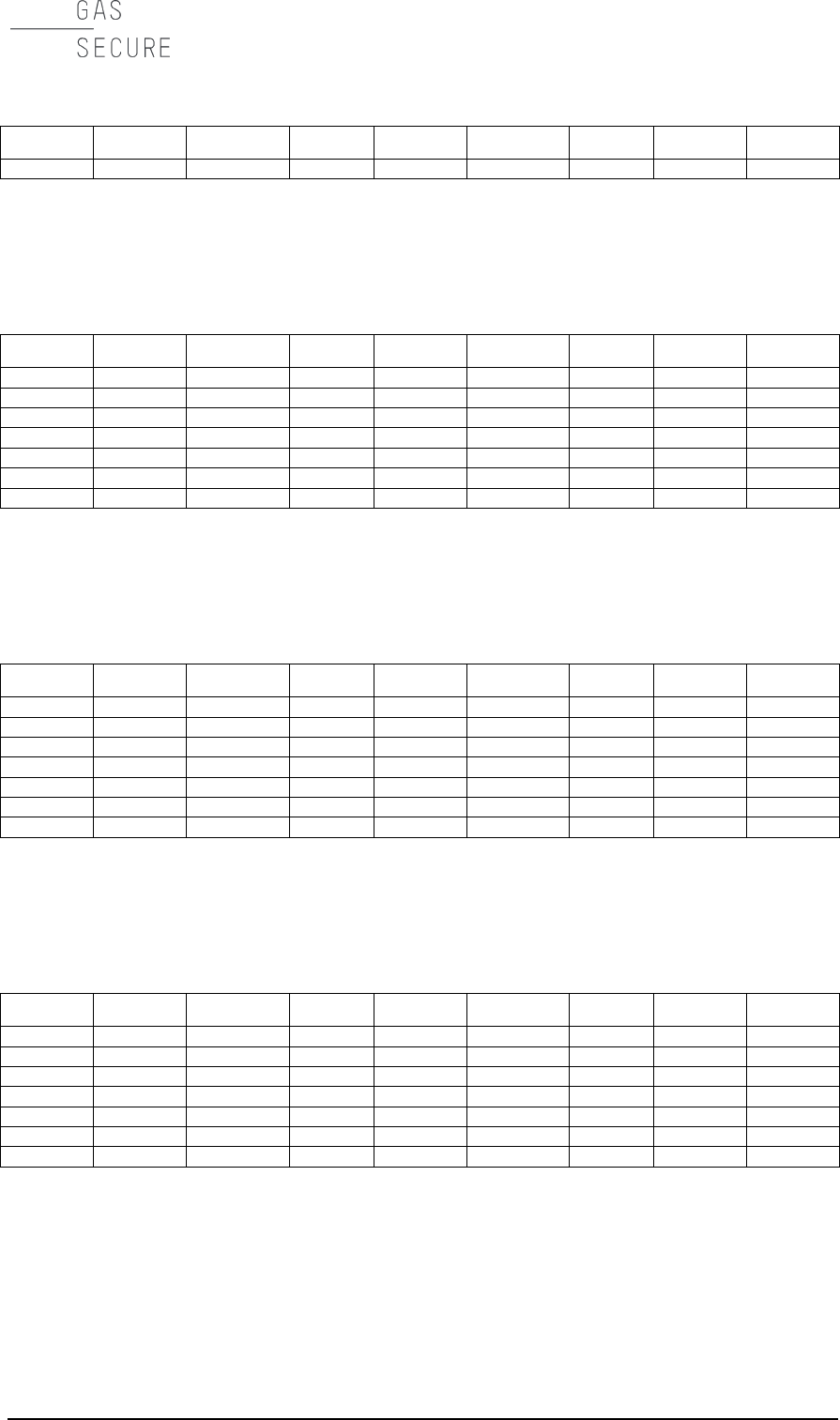
GasSecure GS01
Hardware Manual
TECHNICAL DATA
31
Table 8-2: LEL values in [% vol] according to IEC60079-20.
Methane
Propane
Methanol
Ethanol
Ethylene
N-butane
Hexane
Styrene
Benzene
4.4
1.7
6.0
3.1
2.3
1.4
1.0
1.0
1.2
8.2.1 GS01-01A Methane detector
Table 8-3 Cross sensitivities for a GS01 Methane detector.
Reading
Propane
Methanol
Ethanol
Ethylene
N-butane
Hexane
Styrene
Benzene
10
6
4
6
27
7
7
16
27
20
9
7
10
42
11
11
25
44
30
11
8
13
54
14
14
31
56
40
14
10
15
63
16
17
37
67
50
15
11
17
71
18
19
42
76
75
19
14
21
89
23
24
51
97
100
23
16
25
100
28
29
59
100
8.2.2 GS01-02A Propane detector
Table 8-4 Cross sensitivities for a GS01 Propane detector.
Reading
Methane
Methanol
Ethanol
Ethylene
N-butane
Hexane
Styrene
Benzene
10
24
7
11
47
12
12
28
49
20
79
14
22
91
24
25
53
99
30
160
20
32
130
36
39
75
150
40
200
26
42
170
49
53
95
200
50
>200
31
51
200
62
68
110
>200
75
>200
42
72
>200
97
110
150
>200
100
>200
51
91
>200
130
170
180
>200
8.2.3 GS01-03A Methanol detector
Table 8-5: Cross sensitivities for a GS01 Methanol detector.
Reading
Methane
Propane
Ethanol
Ethylene
N-butane
Hexane
Styrene
Benzene
10
41
14
15
65
16
17
38
68
20
150
30
32
130
36
38
74
150
30
>200
48
49
190
59
65
110
200
40
>200
70
68
>200
89
100
140
>200
50
>200
97
88
>200
130
170
170
>200
75
>200
200
160
>200
>200
>200
200
>200
100
>200
>200
>200
>200
>200
>200
>200
>200

GasSecure GS01
Hardware Manual
32 CHAPTER 8
9. REFERENCES
[RD 1]
Nivis ISA100.11a R2.7 Monitoring Control System User
Guide Version: 1.2, Date: March 30, 2012
[RD 2]
Nivis VersaRouter 900 Hardware User Guide
(VR800 Internal Hardware Rev. C)
Version 1.4, Date: Mar. 18, 2010
[RD 3]
Yokogawa YFGW410 Field Wireless Management Station
user’s manual, IM 01W02D01-01EN
[RD 4]
Yokogawa YFGW410 Field Wireless Management Station
Startup Guide, TI 01W01A56-01EN
[RD 5]
Yokogawa YFGW510 Field Wireless Access Point user’s
manual, IM 01W02E01-01EN
[RD 6]
Honeywell Wireless Device Manager User's Guide, Release
220, OWDOC-X254-en-220A, October 2013
[RD 7]
Honeywell Field Device Access Point User's Guide, Release
220, OWDOC-X256-en-220A, October 2013
[RD 8]
Nivis ISA100.11a Field Tool User Manual, Version 2.1, Date:
October 17, 2013
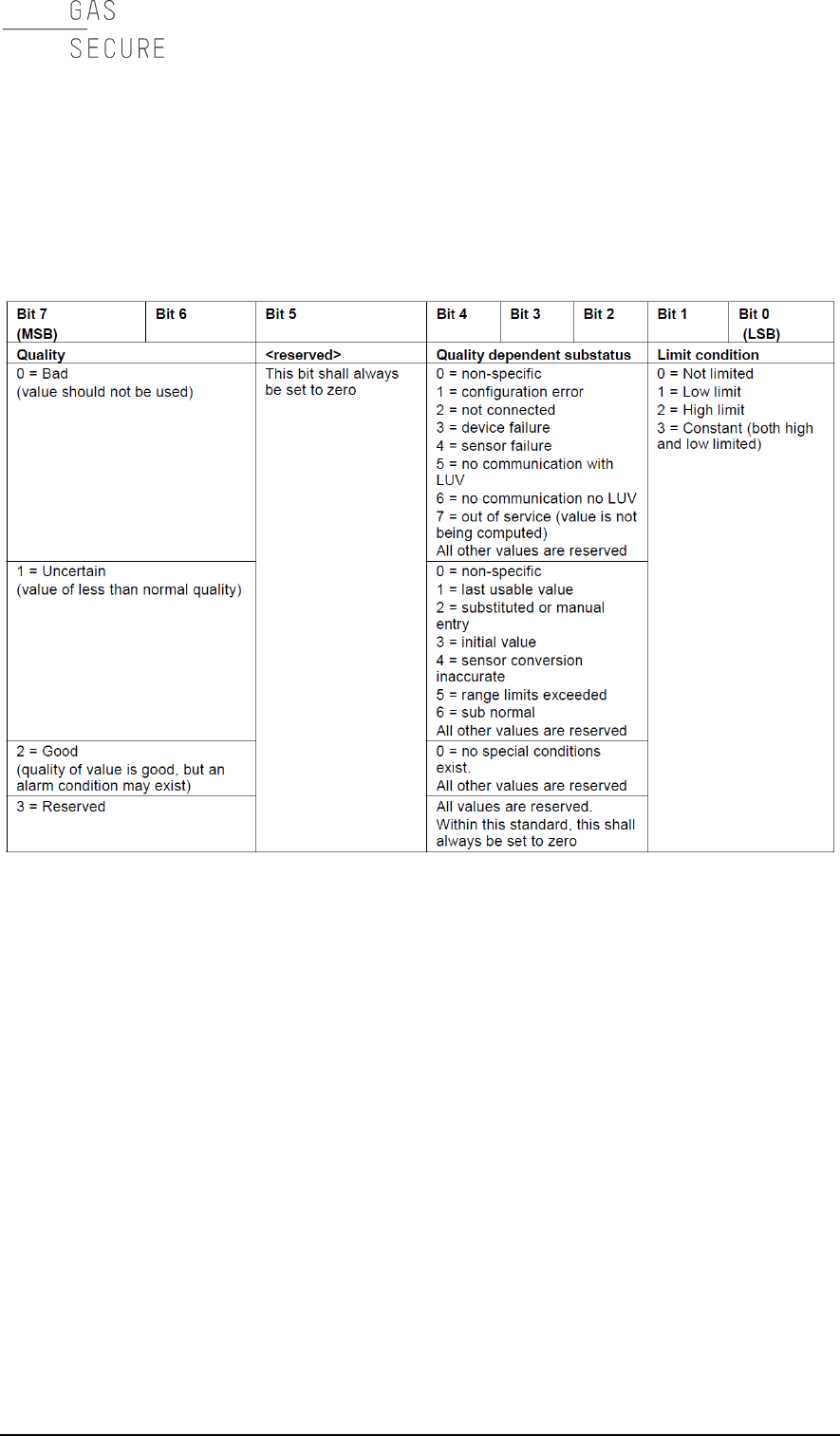
GasSecure GS01
Hardware Manual
APPENDIX
33
10. APPENDIX
Table 10-1: PV_Status byte description according to ISA100 Wireless™ standard
Table 10-2: Content of the DIAG_STATUS attribute
Note also
F: Failure
C: Function check
O: Out of specification
M: Maintenance required
According to the NAMUR NE107 categorization.

GasSecure GS01
Hardware Manual
34 CHAPTER 10
Bit DIAG_STATUS
Not supported if
bit = 0
NAMUR NE107
31 F: Failure Status
30 C: Function check
29 O: Out of specification status
28 M: Maintenance required status
27 Faults in electronics F
26 Faults in sensor or actuator element F
25 Installation, calibration problem C
24 Out out service C
23 Outside sensor limits O
22 Environmental conditions, out of device spec. O
21 Fault Prediction: Maintenance required M
20 Power is critical low: maintenance short term F M
19 Power is low: maintenance long term M
18 Software update incomplete 0 C
17 Simulation is active 0 C
16 Faults due to process influence 0 C
15 Faults due to non-compliance with operation conditions 0 F
14 Other faults 0 F
13 0
12 0
11 0
10 0
09 0
08 Optical beam fault F M
07 Attenuated optical beam M
06 0
05 0
04 0
03 0
02 0
01 0
00 Detail information available 0
Standard settings
Reserved for Baseline
Device Profile
Vendor specific area

GasSecure GS01
Hardware Manual
APPENDIX
35
Recommended implementation of status and diagnostic information
The PV_Status byte and the gas concentration (both published in the PV attribute)
are forwarded to the controller. The gas concentration is displayed as long as the
status byte reads “Good” (decimal value 128) or “Uncertain” (decimal value 64 to
127). When the status byte reads “Bad” (decimal value < 64) the detector will
output NaN 0x7fc00000 (not a number) per float definition in IEEE754.
The diagnostic information as published in the DIAG_STATUS attribute is
forwarded to the maintenance system.
Recommended is to read out the following bits:
- Failure status F (bit 31)
- Maintenance required status M (bit 28).
- Environmental conditions (bit 22)
- Power is critical low (bit 20)
- Power is low (bit 19)
- Optical beam fault (bit 08)
- Attenuated optical beam (bit 07)
Refer to Table 5-2 in the trouble shooting section for description of which actions
need to be taken for the different bit settings.
